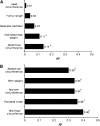Newborn adiposity measured by plethysmography is not predicted by late gestation two-dimensional ultrasound measures of fetal growth
- PMID: 19640967
- PMCID: PMC3151022
- DOI: 10.3945/jn.109.109058
Newborn adiposity measured by plethysmography is not predicted by late gestation two-dimensional ultrasound measures of fetal growth
Abstract
Noninvasive measures of fetal and neonatal body composition may provide early identification of children at risk for obesity. Air displacement plethysmography provides a safe, precise measure of adiposity and has recently been validated in infants. Therefore, we explored relationships between term newborn percent body fat (%BF) measured by air displacement plethysmography to 2-dimensional ultrasound (2-D US) biometric measures of fetal growth and maternal and umbilical cord endocrine activity. A total of 47 mother/infant pairs were studied. Fetal biometrics by 2-D US and maternal blood samples were collected during late gestation (35 wk postmenstrual age); infants were measured within 72 h of birth. Fetal biometrics included biparietal diameter, femur length, head circumference, abdominal circumference (AC), and estimated fetal weight (EFW). Serum insulin, insulin-like growth factor (IGF) 1, IGF binding protein-3, and leptin concentrations were measured in umbilical cord and maternal serum. The mean %BF determined by plethysmography was 10.9 +/- 4.8%. EFW and fetal AC had the largest correlations with newborn %BF (R(2) = 0.14 and 0.10, respectively; P < 0.05); however, stepwise linear regression modeling did not identify any fetal biometric parameters as a significant predictor of newborn %BF. Newborn mid-thigh circumference (MTC; cm) and ponderal index (PI; weight, kg/length, cm(3)) explained 21.8 and 14.4% of the variability in %BF, respectively, and gave the best stepwise linear regression model (%BF = 0.446 MTC + 0.347 PI -29.692; P < 0.001). We conclude that fetal growth biometrics determined by 2-D US do not provide a reliable assessment of %BF in term infants.
Figures


Similar articles
-
Fetal growth parameters and birth weight: their relationship to neonatal body composition.Ultrasound Obstet Gynecol. 2009 Apr;33(4):441-6. doi: 10.1002/uog.6317. Ultrasound Obstet Gynecol. 2009. PMID: 19253324 Free PMC article.
-
Correlation of Fractional Limb Volume Measurements with Neonatal Morphometric Indices.Gynecol Obstet Invest. 2021;86(1-2):94-99. doi: 10.1159/000512749. Epub 2021 Jan 20. Gynecol Obstet Invest. 2021. PMID: 33472205
-
Mid-arm circumference is a reliable method to estimate adiposity in preterm and term infants.Pediatr Res. 2015 Sep;78(3):336-41. doi: 10.1038/pr.2015.103. Epub 2015 May 28. Pediatr Res. 2015. PMID: 26020147
-
Neonatal body composition by air displacement plethysmography in healthy term singletons: a systematic review.BMC Pediatr. 2019 Dec 12;19(1):489. doi: 10.1186/s12887-019-1867-y. BMC Pediatr. 2019. PMID: 31830946 Free PMC article.
-
Origins of obesity in the womb: Fetal adiposity and its determinants.J Obstet Gynaecol Res. 2024 Dec;50(12):2178-2182. doi: 10.1111/jog.16114. Epub 2024 Oct 9. J Obstet Gynaecol Res. 2024. PMID: 39385507 Free PMC article. Review.
Cited by
-
Genetic risk score for prediction of newborn adiposity and large-for-gestational-age birth.J Clin Endocrinol Metab. 2014 Nov;99(11):E2377-86. doi: 10.1210/jc.2013-4221. Epub 2014 Aug 19. J Clin Endocrinol Metab. 2014. PMID: 25137420 Free PMC article.
-
Advances in assessing body composition during pregnancy.Eur J Clin Nutr. 2018 May;72(5):645-656. doi: 10.1038/s41430-018-0152-8. Epub 2018 May 2. Eur J Clin Nutr. 2018. PMID: 29748651 Free PMC article. Review.
-
Newer Insights Into Fetal Growth and Body Composition.Front Endocrinol (Lausanne). 2021 Jul 22;12:708767. doi: 10.3389/fendo.2021.708767. eCollection 2021. Front Endocrinol (Lausanne). 2021. PMID: 34367074 Free PMC article. Review.
-
Fetal growth pathology score: a novel ultrasound parameter for individualized assessment of third trimester growth abnormalities.J Matern Fetal Neonatal Med. 2018 Apr;31(7):866-876. doi: 10.1080/14767058.2017.1300646. Epub 2017 Mar 20. J Matern Fetal Neonatal Med. 2018. PMID: 28277911 Free PMC article.
-
Body composition during fetal development and infancy through the age of 5 years.Eur J Clin Nutr. 2015 Dec;69(12):1279-89. doi: 10.1038/ejcn.2015.117. Epub 2015 Aug 5. Eur J Clin Nutr. 2015. PMID: 26242725 Free PMC article. Review.
References
-
- Ong KK. Size at birth, postnatal growth and risk of obesity. Horm Res. 2006;65 Suppl 3:65–9. - PubMed
-
- Gluckman PD, Pinal E. Regulation of fetal growth by the somatoprophic axis. J Nutr. 2003;133:S1741–6. - PubMed
-
- Gluckman PD. The role of pituitary hormones, growth factors and insulin in the regulation of fetal growth. In: Clarke JR, editor. Oxford reviews for reproductive biology. Oxford: Carendon Press; 1986. p. 1–60. - PubMed
-
- Larciprete G, Valensise H, Di Pierro G, Vasapollo B, Casolino B, Archeini D, Jarvis S, Cirese E. Intrauterine growth restriction and fetal body composition. Ultrasound Obstet Gynecol. 2005;26:258–62. - PubMed
-
- Barker DJP. Mothers, babies and health in later life. 2nd ed. Edinburgh: Churchill Livingstone; 1998. p.1–6.
Publication types
MeSH terms
Grants and funding
LinkOut - more resources
Full Text Sources
Medical
Research Materials
Miscellaneous

